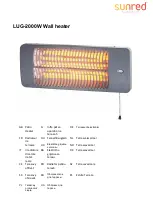
12
2
General venting
Installation & Service Manual
6. After it has been determined that each appliance
remaining connected to the common venting
system properly vents when tested as above,
return doors, windows, exhaust fans, fireplace
dampers and other gas burning appliances to
there previous conditions of use.
7. Any improper operation of the common venting
system
should
be
corrected
so
that
the
installation conforms to the latest edition of the
National Fuel Gas Code, ANSI Z223.1, in
Canada, the latest edition of CAN/CGA
Standard B149 Installation Code for Gas
Burning Appliances and Equipment. When
resizing any portion of the common venting
system, the common venting system should be
resized to approach the minimum size as
determined using the appropriate tables in
Appendix G in the latest edition of the National
Fuel Gas Code, ANSI Z223.1, in Canada, the
latest edition of CAN/CGA Standard B149
Installation Code for Gas Burning Appliances
and Equipment.
A Conventional Vertical Negative Draft
Venting System with Combustion Air
Provided from a Sidewall or Roof Top
Inlet Cap
Follow all requirements in the General Venting section
and Conventional Negative Draft Venting for venting
flue products to the outdoors and general installation
instructions.
This vent system uses two pipes, one vertical pipe with a
roof top termination for the flue products and one pipe for
combustion air. The combustion air pipe may terminate
horizontally with a sidewall air inlet or vertically with a
roof top air inlet. A bell increaser is installed directly
on the vent outlet. This bell increases the vent size by
1” (25.4 mm) in diameter. The bell increaser
MUST
be
installed on the vent outlet for all conventional negative
draft vent systems. Vent connection is made directly to
the bell increaser on top of the appliance. No additional
draft diverter or barometric damper is required on single
appliance installations with a dedicated stack and a negative
draft maintained between 0.02 to 0.05 inches water. The
flue may be combined with the vent from any other
negative draft, Category I appliances. Multiple appliance
installations common vented with other negative draft
appliances require that each appliance must have a barometric
damper installed to regulate draft within the proper range.
The common vent and connectors from multiple appliances
must be sized per the requirements of the venting tables
for type “B” double wall vents in the latest edition of the
National Fuel Gas Code, ANSI Z223.1.
The sidewall or vertical roof top E+Vent combustion air
supply system has specific vent material and installation
requirements. The air inlet pipe connects directly to the
appliance to supply combustion air. In most installations,
the combustion air inlet pipe will be a dedicated system with
one air inlet pipe per appliance. Multiple air inlets may be
combined if the guidelines in “Combined Air Inlet Points”
are followed. The air inlet pipe will be connected to a
combustion air inlet cap as specified in this section.
Combustion air supplied from outdoors must be free of
contaminants (see
Combustion and Ventilation Air Section
).
Figure 2-6 E+ Vent with Sidewall Air
Sidewall Air Inlet
The sidewall air inlet cap is supplied in the E+Sidewall Vent
Kit which should be ordered from the manufacturer. This
sidewall cap will supply combustion air for a single appliance
only.
Locate appliances as close as possible to sidewall where the
combustion air supply system will be installed.
To prevent recirculation of flue products from an adjacent
vent cap into the combustion air inlet, follow all applicable
clearance requirements in the latest edition of the National
Fuel Gas Code and instructions in this manual.
The combustion air inlet cap must be installed at least one
foot (30 cm) above ground level and above normal snow
levels.
Содержание Efficiency-Pac EW 150 -- 300
Страница 47: ...47 Notes ...













































